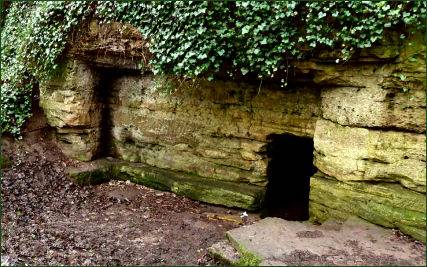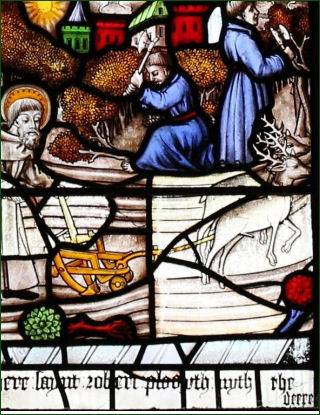St. Robert's Cave, Knaresborough
OS grid reference:-
St Robert's Cave beside the River Nidd at Knaresborough is a rare survival of a medieval hermit's home. This site attracted thousands of pilgrims in the Middle Ages. The small cave is carved into the face of the limestone cliff, and the remains of a chapel and St. Robert's living area still remain.


Robert of Knaresborough lived in the cave site (then known as St. Giles' Priory) in the late twelfth and early thirteenth centuries, visiting pilgrims believed that their ailments could be cured by Robert. King John is reputed to have visited him and Trinitarian friars also venerated him. Towards the end of his life, pilgrims flocked to see Robert to seek spiritual guidance. His brother Walter, then Mayor of York, came and paid for some new buildings, including a chapel dedicated to the Holy Cross.
The floor plan can still be seen alongside Robert's cave in Knaresborough today. St. Robert's Cave is situated between Abbey Road and the River Nidd There is a path from the road down to the cave and ruins of the chapel.
St. Robert of Knaresborough
 St. Robert of Knaresborough was born in 1160 to a wealthy family in York, he was known as Robert Flower or Fleur, the son of Touk Flower, the mayor of York. From childhood Robert was intent on pursuing a religious vocation. Early in life he became a a lay brother at the Cistercian abbey of Newminster in Northumberland, but he only remained there a few months.
St. Robert of Knaresborough was born in 1160 to a wealthy family in York, he was known as Robert Flower or Fleur, the son of Touk Flower, the mayor of York. From childhood Robert was intent on pursuing a religious vocation. Early in life he became a a lay brother at the Cistercian abbey of Newminster in Northumberland, but he only remained there a few months.
Searching for a life of solitude and contemplation, he visited a knight/hermit who lived in a cave by the river Nidd at Knaresborough. He shared the cave with the knight who was in hiding out from King Richard I, on the death of the king the knight returned to his home leaving Robert alone. He continued to live there for some years, until a wealthy widow, Juliana, offered him a cell at the nearby St. Hilda's Chapel at Rudfarlington in Knaresborough Forest. There he developed a reputation as a wise and holy man who cared for the poor. Robert stayed there just a year before his hermitage was destroyed by bandits. He then lived for a time under the church wall at Spofforth and then tried living with monks at Hedley, near Tadcaster.
Robert eventually returned to Rudfarlington and for a time prospered, employing four servants and keeping cattle. But he got into trouble with William de Stuteville, the constable of Knaresborough Castle who accused him of harbouring thieves and outlaws. Robert was famous for his charity to the poor and destitute. Having his hermitage destroyed for the second time, Robert returned to the cave at Knaresborough, where he remained for the rest of his life. William de Stuteville was succeeded by Brian de Lisle, who regarded the hermit as a friend.
Although living as a recluse, his piety soon attracted followers and gifts from local benefactors which included land alongside the river. A number of stories of St. Robert exist both in Latin and Early English verse. One concerns his complaining about the King's deer eating his crops. Sir William, amusing himself at the expense of Robert, invited him to catch the offending beasts. Robert not only manages to herd the deer into his barn as if they were a tame flock of sheep, but also harnesses them to his plough and sets them to work.
It is reported that King John, who often stayed at Knaresborough Castle visited him in his cave. Towards the end of Robert's life, pilgrims flocked to see him to obtain spiritual guidance and to be healed of their ailments. His brother Walter, then Mayor of York, also came and paid for some new buildings, including a chapel dedicated to the Holy Cross.
Robert died on 24 September 1218. Before his death St Robert established an order of Trinitarian Friars at Knaresborough Priory, but he warned them that when his time came the monks of Fountains abbey would try to carry his body away to their own establishment, he urged his followers to resist them, which they did and so St Robert was buried in his chapel cut from the steep rocky crags by the river, where it was said that a medicinal oil flowed from his tomb and pilgrims came from near and far to be healed by this.
